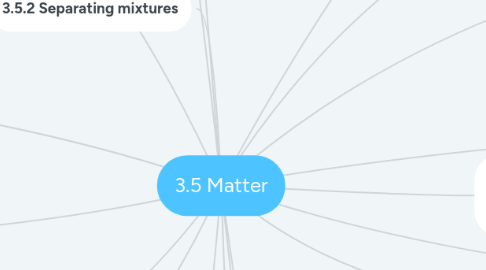
1. Solvent: A substance, normally a liquid, that dissolves another substance
2. Explain changes in states in terms of changes to the energy of particles.
3. Properties of solids, liquids and gases can be described in terms of particles in motion but with differences in the arrangement and movement of these same particles: closely spaced and vibrating (solid), in random motion but in contact (liquid), or in random motion and widely spaced (gas). Observations where substances change temperature or state can be described in terms of particles gaining or losing energy.
3.1. Explain unfamiliar observations about gas pressure in terms of particles.
4. Keywords
4.1. Solute: A substance that can dissolve in a liquid
4.2. Filtration: Separating substances using a filter to produce a filtrate (solution) and residue
4.2.1. Solution: Mixture formed when a solvent dissolves a solute
4.2.1.1. Evaporation: A way to separate a solid dissolved in a liquid by the liquid turning into a gas.
4.3. Distillation: Separating substances by boiling and condensing liquids.
4.4. Chromatography: Used to separate different coloured substances.
5. Pure substance: Single type of material with nothing mixed in
6. Devise ways to separate mixtures, based on their properties
6.1. A pure substance consists of only one type of element or compound and has a fixed melting and boiling point. Mixtures may be separated due to differences in their physical properties. The method chosen to separate a mixture depends on which physical properties of the individual substances are different.
6.1.1. Skill Use techniques to separate mixtures.
6.1.2. Fact Air, fruit juice, sea water and milk are mixtures. Liquids have different boiling points.
6.1.3. Apply
6.1.3.1. Explain how substances dissolve using the particle model.
6.1.3.2. Use the solubility curve of a solute to explain observations about solutions.
6.1.3.3. Use evidence from chromatography to identify unknown substances in mixtures.
6.1.3.4. Choose the most suitable technique to separate out a mixture of substances.
7. Particle model: A way to think about how substances behave in terms of small, moving particles.
8. Mixture: Two or more pure substances mixed together, whose properties are different to the individual substances.
9. 3.5.2 Separating mixtures
9.1. Dissolve: When a solute mixes completely with a solvent.
10. Make predictions about what will happen during unfamiliar physical processes, in terms of particles and their energy.
11. Argue for how to classify substances which behave unusually as solids, liquids or gases.
12. Evaporate: Change from liquid to gas at the surface of a liquid, at any temperature.
13. Particle: A very tiny object such as an atom or molecule, too small to be seen with a microscope.
14. Explain the properties of solids, liquids and gases based on the arrangement and movement of their particles.
15. Evaluate observations that provide evidence for the existence of particles.
16. Freeze: Change from liquid to a solid when the temperature drops to the melting point.
17. Draw before and after diagrams of particles to explain observations about changes of state, gas pressure and diffusion.
18. Gas pressure: Caused by collisions of particles with the walls of a container
19. 3.5.1 Particle model
19.1. Relate the features of the particle model to the properties of materials in different states
19.1.1. Solubility: Maximum mass of solute that dissolves in a certain volume of solvent.
19.1.1.1. Soluble (insoluble): Property of a substance that will (will not) dissolve in a liquid.
19.2. Keywords
19.2.1. Diffusion: The process by which particles in liquids or gases spread out through random movement from a region where there are many particles to one where there are fewer.
19.2.2. Fact A substance is a solid below its melting point, a liquid above it, and a gas above its boiling point.
19.2.3. Boil: Change from liquid to a gas of all the liquid when the temperature reaches boiling point.
19.2.4. Condense: Change of state from gas to liquid when the temperature drops to the boiling point.
19.2.5. Melt: Change from solid to liquid when the temperature rises to the melting point
19.2.6. Sublime: Change from a solid directly into a gas
